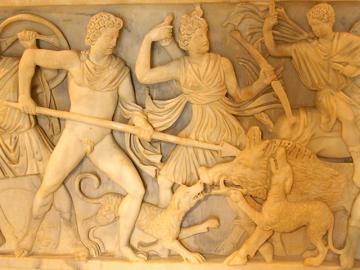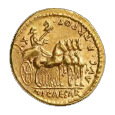The Economics of Roman Art
The sixth OXREP conference (Oxford, September 26–27, 2011) will focus on the economics of Roman Art. Confirmed speakers include Andrew Wilson, William Harris, Janet DeLaine, Rolf Schneider, Will Wootton, Domenico Esposito, Miko Flohr, Ben Russell, Susan Kane, Julie van Voorhis, Amanda Claridge, Simona Perna and Susan Walker. The conference will be held in the lecture theatre of the Ioannou Centre for Classical and Byzantine Studies. The conference programme is available below.
The Roman world produced an astounding quantity of artistic works for display in both public and private settings – statues, mosaics, wall paintings, architectural sculpture, jewellery, etc. The archaeological record shows a quantity and distribution of such works between the first century BC and the third century AD unmatched in any other pre-industrial society. Cumulatively they suggest a colossal degree of expenditure on ultimately unproductive works, sufficient to sustain a whole economic sector of artists and artisans in their production. Despite this, the economics of producing, selling and consuming artistic works have tended to received only limited attention in scholarly debates about Roman art, while art as a product category is more or less absent from discussions of the Roman economy. The conference will bring together both ancient art historians and ancient economic historians – rather than focusing on the practicalities of production in different media, it poses a broader question: what does the study of the economics of artistic production add to our understanding of both the Roman economy and Roman art history?
Artistic production is not often discussed in this context but questions of patronage, consumption, craft organisation, production techniques and access to materials, and their changes over time, have much to contribute to this debate, particularly the question of economic growth. To what extent, for example, do changes in artistic output mirror economic developments? Who was investing in art and how much were they spending? Was investment equally spread across the Roman Empire and how did it change over time? What effect did artistic production have on the economies of individual urban centres? How far down the social strata were different types of work affordable? What does the trade in works of art, as well as raw materials, add to our understanding of connectivity in this period? How did changing patterns of demand effect modes of production? What was the scale of production? Can we detect relationships between patronage and artistic quality? Overall, and in addition to posing specific questions of the evidence, this conference seeks to explore more generally the potential, as well as the limits, of this kind of investigation: when, in other words, is artistic production a genuinely useful source for economic analysis, and when are we simply pushing the evidence too far?
Programme
Download the programme as a pdf.
| Monday 26 September | |
| 09.00 |
Introduction
Andrew Wilson |
| Session 1: Approaching artistic production from an economic perspective | |
| 09.30 |
Auctoritas rerum: a model for the economics of art in the Roman Empire
William Harris |
| 10.30 | Coffee break |
| 11.00 |
Keeping up with the emperors: the cost of building on imperial lines
Janet DeLaine |
| 12.00 |
Building sites: art, marble, money
Rolf Schneider |
| 13.00 | Lunch break |
| Session 2: Art production and the urban context | |
| 14.00 |
Figuring out the facts: some attempts to calculate and cost mosaic production
Will Wootton |
| 15.00 |
Sed nulla Gloria artificum est… economy and production of Roman wall‐paintings
Domenico Esposito |
| 16.00 | Tea break |
| 16.30 |
The domestic art economy: understanding Pompeii
Miko Flohr |
| 17.30 | Closing Discussion |
| 18.00 | Drinks |
| Tuesday 27 September | |
| Session 3: Marble, stone and sculpture | |
| 09.00 |
Art and the stone trade: quarries, carvers, customers
Ben Russell
|
|
10.00 |
Marble supply and statuary production in Cyrene in the Hellenistic and Roman periods
Susan Kane |
| 11.00 | Coffee break |
| 11.30 |
Local sculptors, local markets: the economy of marble sculpture at Aphrodisias in Caria
Julie van Voorhis |
| 12.30 | Lunch break |
| 13.30 |
‘Mass production’ in Roman marble statuary
Amanda Claridge |
| Session 4: Status and expenditure on conspicuous display | |
| 14.30 |
Tanta marmoris luxuria est. Roman cinerary urns in coloured stone: aspects of production and consumption
Simona Perna |
| 15.30 | Tea break |
| 16.00 |
Glass in Rome for princeps and populus
Susan Walker |
| 17.00 | Closing Discussion (led by Andrew Wilson and Bert Smith) |
| 17.30 | Drinks |




